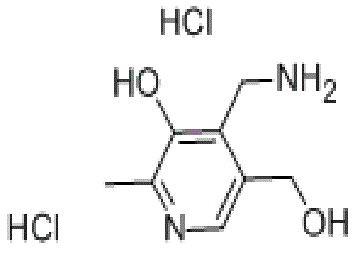English Synonyms
PYRIDOXAMINE HCL;Pyridoxamine Dihydrochloride Monohydrate;2-Methyl-3-hydroxy-4-aminomethyl-5-hydroxymethylpyridine dihydrochloride;Dyridoxamine hydrochloride;Pyridoxamine·2hydrochloride;vitamin B6dihydrochloride;Pyridoxamine dihydrochloride,4-(Aminomethyl)-5-hydroxy-6-methyl -3-pyridinemethanol dihydrochloride;Pyridoxamine dihydro
Pyridoxine hydrochloride Properties
| Melting Point | 224-226 °C (dec.)(lit.) |
| Density | 1.4025 (rough estimate) |
| Refractive Index | 1.6100 (estimate) |
| Storage Condition | Inert Atmosphere,Store in Freezer, Under -20°c |
| Solubility | Dmso (A Little), Methanol (A Little), Water (A Little) |
| Form | Powder or Solid |
| Acidity Coefficient (pKa) | pKa 3.31(H2O
t = 25
I = 0.1)(Approximate) |
| Color | White to Off-White to Light Brown |
| Water Solubility | Soluble in Dmso, Water, Or Methanol/N |
Pyridoxine Hydrochloride Usage and Synthesis
Introduction
Pyridoxine Hydrochloride Belongs to the Vitamin Class of Drugs, White to Slightly Yellow Crystals or Crystalline Powder; It Is Easily Soluble in Water, Slightly Soluble in Ethanol, And Insoluble in Ether or Chloroform. It Can Be Used in Biochemical Research, And Its Pharmacological Effects Are the Same as Those of Vitamin B6.
Application
Pyridoxine Hydrochloride Is a White or Nearly White Crystalline Powder with a Density of 1.282 G/Cm3, A Melting Point of 24-226 °c (Dec.)(Lit.), A Boiling Point of 460.1ºc at 760 Mmhg, And a Flash Point of 232.1ºc. Compound 3D B for Injection Is a Compound Preparation, Which Contains Fursultiamine Hydrochloride, Pyridoxine Hydrochloride and Vitamin B12, And Is Used to Treat Peripheral Nerve Damage, Multiple Neuritis, Trigeminal Neuralgia, Pernicious Anemia, Nutritional Anemia, Etc.
Preparation Method
Pyridoxine Hydrochloride Can Be Obtained by Oxidation with Manganese Dioxide, Condensation with Hydroxylamine, And Then Reduction with Metallic Zinc.
Safety Information
If Pyridoxine Hydrochloride Is Inhaled, Move the Patient to Fresh Air; if Skin Contact Occurs, Remove Contaminated Clothing, Rinse the Skin Thoroughly with Soap and Water, And Seek Medical Attention if You Feel Any Discomfort; if Eye Contact Occurs, Open the Eyelids, Rinse with Running Water or Saline, And Seek Medical Attention Immediately; if Ingested, Rinse the Mouth Immediately, Do Not Induce Vomiting, And Seek Medical Attention Immediately. Advice for Protecting Rescuers Is as Follows: Move the Patient to a Safe Place, Consult a Doctor, And if Conditions Permit, Show This Chemical Safety Data Sheet to the Doctor on Site. If Leaked, Collect the Leaked Liquid in a Sealed Container as Much as Possible for a Small Amount of Leak, Absorb It with Sand, Activated Carbon or Other Inert Materials, And Transfer It to a Safe Place. Do Not Flush It into the Sewer; if a Large Amount of Leak Occurs, Build a Dike or Dig a Pit to Contain It, Close the Drainage Pipe, Cover It with Foam, Suppress Evaporation, And Transfer It to a Tank Truck or Special Collector with an Explosion-Proof Pump for Recycling or Transport It to a Waste Treatment Site for Disposal.


